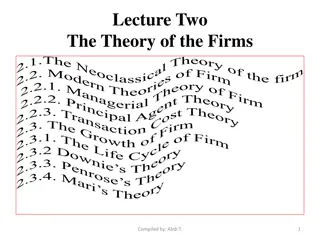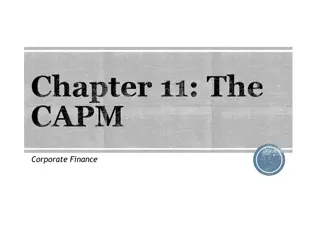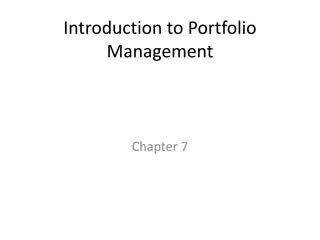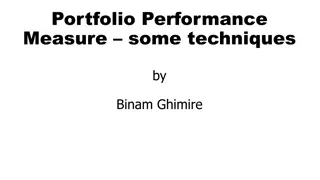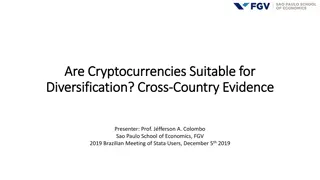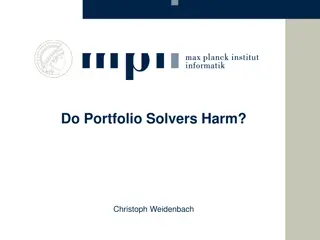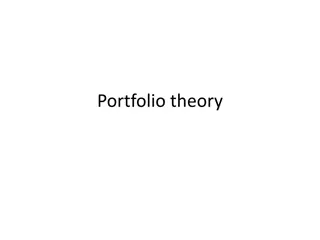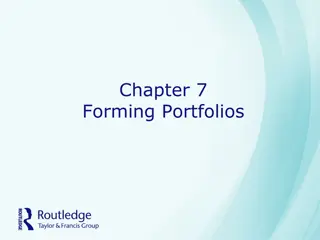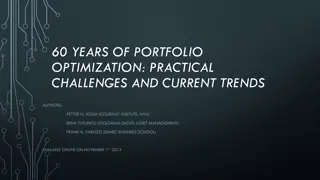
Understanding Modern Portfolio Theory and Risk Measurements
Explore Modern Portfolio Theory (MPT) and different statistical risk measurements such as Alpha, Beta, R-Squared, Sharpe Ratio, and Standard Deviation. Learn how MPT helps investors optimize returns while managing risks effectively.
Download Presentation

Please find below an Image/Link to download the presentation.
The content on the website is provided AS IS for your information and personal use only. It may not be sold, licensed, or shared on other websites without obtaining consent from the author. If you encounter any issues during the download, it is possible that the publisher has removed the file from their server.
You are allowed to download the files provided on this website for personal or commercial use, subject to the condition that they are used lawfully. All files are the property of their respective owners.
The content on the website is provided AS IS for your information and personal use only. It may not be sold, licensed, or shared on other websites without obtaining consent from the author.
E N D
Presentation Transcript
SUBMITTED TO: PROF: SUBINA SYAL SUBMITTED BY: HARSIMRAN KAUR(501) SIMARJOT KAUR(503)
INTRODUCTION Modern portfolio theory (MPT) is a theory on how risk-averse investors can construct portfolios to optimize or maximize expected return based on a given level of market risk, emphasizing that risk is an inherent part of higher reward.
EFFICIENT FRONTIER The efficient frontier is the set of optimal portfolios that offer the highest expected return for a defined level of risk or the lowest risk for a given level of expected return. Portfolios that lie below the efficient frontier are sub-optimal because they do not provide enough return for the level of risk.
PORTFOLIO RISKAND EXPECTED RETURN MPT makes the assumption that investors are risk-averse, meaning they prefer a less risky portfolio to a riskier one for a given level of return. This implies that an investor will take on more risk only if he or she is expecting more reward. The expected return of the portfolio is calculated as sum of the individual assets. If a portfolio contained four equally- weighted assets with expected returns of 4, 6, 10, and 14%, the portfolio's expected return would be: (4% x 25%) + (6% x 25%) + (10% x 25%) + (14% x 25%) = 8.5%
TYPES OF STATISTICAL RISK MEASUREMENTS IN PORTFOLIO THEORY Alpha Alpha refers to the measurement of an investment's performance on a risk-adjusted basis. It takes the instability (value chance) of a security or store portfolio and thinks about its hazard balanced execution to a benchmark list. A positive alpha of 1 implies the store has beaten its benchmark file by 1%. Correspondingly, a comparative negative alpha would show an underperformance of 1%. Beta Beta is defined as a measure of the volatility, or systematic risk, of a security or a portfolio when compared to the market as a whole. It is calculated using regression analysis. A beta of under 1 shows the venture will be less unpredictable than the market.
R-Squared R-Squared is a factual measure that speaks to the level of a reserve portfolio's or security's developments that can be clarified by developments in a benchmark record. R-squared qualities extend from 0 to 100. Sharpe Ratio Sharpe ratio can be identified as a measurement of the expected excess return of an investment in relation to its return volatility. The proportion estimates the normal return in abundance of the hazard free rate per unit of vulnerability to decide how much extra return a financial. Standard Deviation This element related to investment risk uses the return of an investment to measure the investment s volatility by comparing it to the historical returns of the security rather than a benchmark index like it's done in case of Beta.
INVESTMENT PORTFOLIO An investment portfolio is a set of financial products with a strategic asset allocation of each of them. A smart investor takes a diligent and disciplined approach to invest their money in financial assets that minimize their risk and reward them with good returns. Portfolio investment may include a wide range of financial assets like stocks, futures, and options, derivatives, Real Estate Investment Trusts (REITs), mutual funds, government bonds, Exchange-Traded Funds (ETFs), corporate bonds, physical instruments like gold, commodities, rental properties, etc.
HOW MODERN PORTFOLIO THEORY WORKS? There are a few instances of Modern portfolio hypothesis, with handy precedents the possibility of Modern portfolio hypothesis can be elucidated, here, two of models are examined underneath: In resource class, stocks are commonly less secure than the bonds. Suppose a portfolio has the two stocks and offers, it is seen that it might achieve sensible profit for lower dangers. On the venture level, it is seen that remote stocks and little top stocks create high dangers than the expansive top stocks. On the off chance that these three classes are assembled, the outcome will be normal returns for normal hazard.





